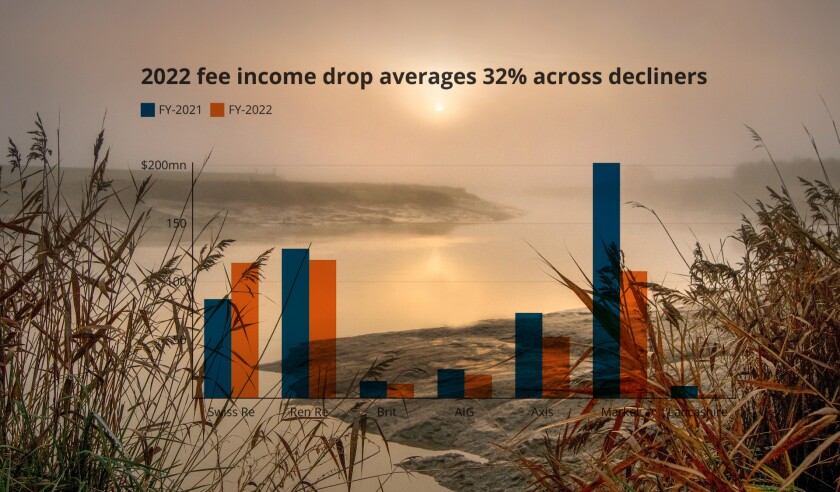Swiss Re was one of two to report asset under management (AuM) growth among this peer group of seven, up 32% to $2.9bn, driving fee income up 36% to $116mn. It had opened an internal cat bond fund to third-party capital last year and raised capital from Swedish pension scheme Alecta to its 1863 Fund.
The decline in fees across the rest of the group generally mirrored the direction of their assets under management, which was mostly downward where updates were provided.
The average drop in fee income was around 30%, excluding Swiss Re’s experience.
RenaissanceRe put in the strongest fee income performance among the rest, in that its drop was limited to single digits at 8%. The firm’s third-party platforms had some success in fundraising at 1 January, with DaVinci adding $377.2mn and Medici $25.7mn, in addition to funds raised across the Capital Partners business throughout 2022.
Its AuM was down 14% at $6.4bn as of the end of September 2022, according to the latest figure in Trading Risk’s regular AuM survey.
Markel, which owns Nephila, the largest of the reinsurer-owned funds at $7.4bn AuM, recorded a more precipitous drop off in revenues, which were down by 46% to $109mn, for the year, after it sold some of its ILS MGAs.
Markel’s 10-K subsequently disclosed an even leaner revenue figure for Nephila itself of $79.5mn, a 44% fall from 2021 after the sale of Velocity.
While Markel’s report on its ILS operations sought to accentuate the positive impacts of rising cat rates on Nephila’s projected performance and growth potential, it acknowledged that these favourable trends were “more than offset” by declines in capital.
Nephila did attract a $200mn injection of fresh capital in January, but even including this, AuM was down on a year earlier by 16%.
The numbers point to a wider, cross-market challenge for all ILS platforms that built up operations during the years of healthy inflows to support large and often growing AuM bases. These firms must now countenance the reality of managing their operating outlay in the context of existing capital AuM that may be shrinking, while new capital is wary, expensive and has lots of other attractive options.
AIG’s AlphaCat platform, which stood at AuM of $3.1bn as of January, according to Trading Risk data, generated fee income of $20mn, down 20%, in the year.
The ILS manager’s performance was impacted by Hurricane Ian, according to AIG, which itself took a loss of $3mn in investment income from AlphaCat, impacted by a $26mn downturn in Q3.
Sub-$1bn reinsurer-owned managers
The two reinsurers in the peer group with sub-$1bn ILS units – Brit and Lancashire – do not regularly disclose AuM figures. Both reported a fall in fee income year-over-year and Lancashire Capital Management business has shrunk significantly over the past year.
Lancashire CEO Alex Maloney’s comment to this publication on ILS market conditions was that terms offered by third-party capital providers “weren’t attractive” and that fundraising had been extremely challenging. This explained why it had taken the call at some point in the January renewal process to write risks through its balance sheet business rather than draw down funds at 1 January.
In turn, this gave context for the 71% year-over-year drop in fee income at Lancashire Capital Management, down to $3.1mn.
Brit’s fee income performance was one of the stronger of the group, given the widespread declines, down by a relatively modest 16% at $12.3mn for 2022. In the absence of an AuM update from Brit, figures were left level with last year’s $300mn.
Axis is the final member of the reinsurer-owned group that has put out ILS fee income numbers for 2022. The reinsurer made a well-documented exit from property cat in early June last year. Fee income at the firm’s ILS unit declined by 28% to $52.7mn over the year.
At the time of Axis’s exit from cat, Trading Risk asked if the firm’s decision was the canary in the coalmine of a hard property cat market, with one commentator saying they thought Axis was unlikely to be last out of cat lines.
The slow turning of the property cat tide from hard to soft throughout the course of 2022 does appear to have exposed ILS managers to a hit on fee income that has impacted on some harder than others.


